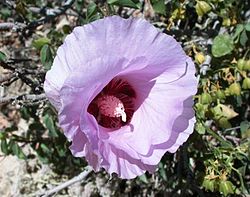Gossypium sturtianum
| Habit | shrub
| |
|---|---|---|
| Height: | ⇕ | 3 ft"ft" can not be assigned to a declared number type with value 3. to 10 ft"ft" can not be assigned to a declared number type with value 10. |
| Width: | ⇔ | 3 ft"ft" can not be assigned to a declared number type with value 3. |
| Lifespan: | ⌛ | perennial |
| Bloom: | ❀ | early summer, mid summer, late summer |
| Exposure: | ☼ | sun |
|---|---|---|
| Features: | ✓ | flowers, fruit |
| USDA Zones: | 10 to 12 | |
| Flower features: | ❀ | red, pink |
Sturt's Desert Rose (Gossypium sturtianum) is a woody shrub, closely related to cultivated cotton, found in all mainland states of Australia and the Northern Territory. It has a life cycle of about 10 years, grows from 1–2 m tall and 1–2 m wide.
The colour of the petals can range from pale pink to dark purple to maroon. The five petals are arranged in a whorl and have a dark red centre. There is a small cotton spore in the centre of the flower. They can be seen for most of the year but peak in late winter. They are up to 12 cm in diameter. The leaves are different shades of green, round and strongly scented when crushed.
There are two variations of the Sturt's Desert Rose. Variation nandewarense is found only in north-eastern New South Wales (around Narrabri) and the Expedition Range in central Queensland. The more common variation, sturtianum, is found everywhere else.
The Sturt's Desert Rose is found in sandy and gravelly soils, along dry creek beds, watercourses, gorges and rocky slopes. This means that it must be able to store and conserve water. Adaptations for this plant include:
- A strong internal structure. This prevents wilting and reduces transpiration (sweat).
- There are fewer stomata (the pores that release gas in the leaves) or they are protected. The stomata on the Sturt's Desert Rose are found on the underside of the leaf. This means reduced water loss.
- They have internal water storage. This reduces the need to rely on rain to stay watered. These sources could be in the trunk, root system or leaves.
- Deep root systems. They are able to reach the water deep under the ground.
- The seeds of the plant do not function before they are germinated. This means they have more chance of surviving.
- Sturt's Desert Rose contains the substance gossypol. Gossypol is toxic to all non-ruminant (cud-chewing) animals. This means the shrub has less chance of being eaten.
Cultivation
Propagation
Pests and diseases
Varieties
Gallery
References
External links
- w:Gossypium sturtianum. Some of the material on this page may be from Wikipedia, under the Creative Commons license.
- Gossypium sturtianum QR Code (Size 50, 100, 200, 500)
